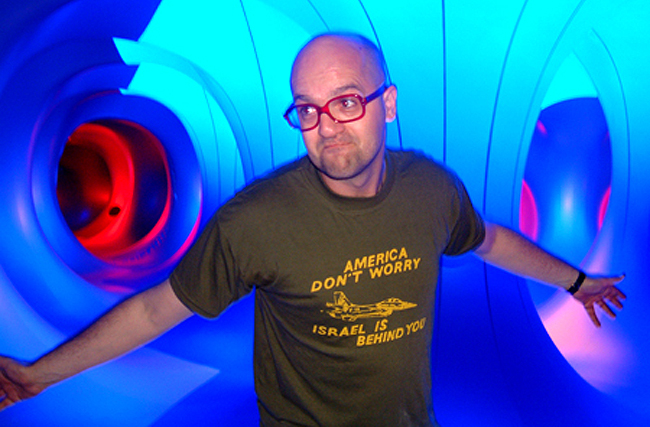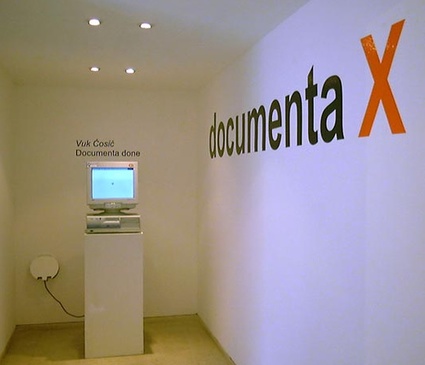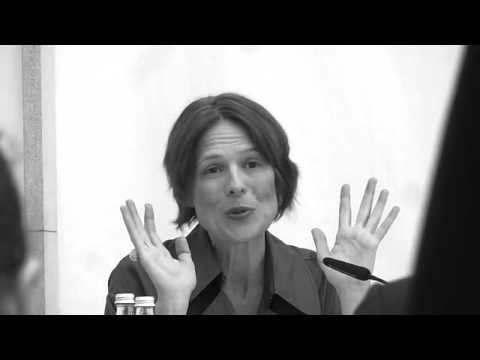Vuk Ćosić: Digital Archaeologist
17 de agosto de 2012 Cosic portrait
Cosic portraitIn the postgraduate course Art and Digital Culture UOC-LABoral that took place this year between March and July, the students developed, either individually or in groups, a final essay in which they explored a particular aspect of the relationship between art, technology and society. Among these essays, the outstanding document written by students Paz Diman and Laia Ros titled «Resistance is fertile» focused on a series of interviews that outline the media art scene in the context of Las Palmas de Gran Canaria (Canary Islands, Spain) and Ljubljana (Slovenia). We reproduce below the conversation between Laia Ros and net art pioneer Vuk Ćosić.
By Laia Ros
Vuk Ćosić (Belgrade, 1966). Digital archaeologist from Belgrade; he was a part of a small group of pioneers working in Internet art who have been actively shaping and establishing net.art in the 1990’s. He is also accused of being responsible for recognizing the potential and aesthetic aspects of ASCII code. He is known to state “Code is poetry”. In 1991, he moved to Trieste and in 1993 he finally settled in Slovenia. Together with Marko Peljhan, he was one of the engines of New Media Art in Slovenia, striving to place Ljubljana onto the art and technology’ world map. Since then he has been active in politics, literature and arts. His contstantly evolving artwork is characterized by an interesting mix of research in low-tech aesthetics, economics, ecology and archaeology of the media on the one hand, and an innovative feeling for contemporary urban and underground aesthetics on the other. The most notable venues include, among many others, Videotage, Hong Kong ; Media Artlab, Tel Aviv ; Venice Biennial; MIT Medialab; Walker Center, Minneapolis ; Postmasters, NYC; Kunsthalle, Vienna ; LAMoCA, Los Angeles ; ICA, London and Beaubourg , Paris.
How did you come to use new media or Internet as a means of artistic expression?
Several trajectories in my life had to come together in order for this to happen. Firstly, in 1991 I emigrated from what was at the time Yugoslavia and came to Slovenia. The second influence was my development as an artist. I was trying to escape literature, and was greatly inspired by Duchamp, Broodthaers and a guy called Vlado Martek from Croatia, an excellent conceptual artist. All of them abandoned their main artistic disciplines and started exploring space beyond literature or painting. And I was influenced by this concept of expanded media. These two things were taking place simultaneously, I was leaving these two spaces behind, one was my own country, the physical territory and the other was the artistic practice that I somehow belonged to and decided to abandon. Thus, I was completely open and at a crossroads when the Web fell on my head. I believe my first encounter with it was in early 1993. I experienced it as an automatic, immediate epiphany, you know. It was a totally religious experience and because I was so volatile, so open, free, and without attachment, I was easily hooked. If I was slightly older or a bit more stable, I would be more reluctant and I would let it go, I wouldn’t jump on it so fast. So I guess that what I am describing are in fact two lucky circumstances. After that I started posing questions, as many and as often as I could, serious conceptual and strategic questions about the meaning of art and I didn’t just want to do reproductions of my usual stuff on-line.
Some theoreticians are of the opinion that net.art was the last vanguard art in the 20th century and that charismatic artists integrated it. We could consider that net.art was a movement of critical and political landmark. What did you find exciting? What did you wish to provoke?
Actually, the first exciting thing was not truly social or political. It was closer to artistic psychology. I was always frustrated – in a positive sense of the word – by the example of the historic avant-‐gardes and the chemistry between the actors at a distance. Like you know, how Marinetti travelled to Moscow in 1930 and met Mayakovski and shit like that. I always found things like this fascinating, already from my early formative years onwards. And with net.art it was of cardinal importance for me to get acquainted with people (at great distances) that I could sense, practically smell and who had a similar pathological mentality to mine. The act of recognition was the erotic point that confirmed I was doing a meaningful thing. Once I reached this understanding with the other guys, it was the question of what do we want to achieve, who are we talking to or at. Our first fascination was the tool itself. We all emigrated in our own way into this new practice and we all had our own grudges, our own frustrations to cure. We could say it was a dynamic balance. We were simply trying to invent a new way, establish a space of freedom, our own world, a creative discourse itself.
Lev Manovich stated that “1990s net.art was the first international art movement since the 1960s that included East Europe in a big way. Prague, Ljubljana, Riga, and Moscow counted as much as Amsterdam, Berlin, and New York. Equally including artists from the West and the East, net.art perfectly corresponded to the economic and social utopia of a new post Cold War world of the 1990s.” Some of the pioneers of the net.art movement are coming from the Eastern Europe. Do you think that the location has an influence in this particular case (net.art), or in general?
Paradoxically, with the fall of the Berlin wall in the 80s, there was this grand expectation of an outpour of creativity from this closed world. And then this expectation fell on us, on our group. However, I believe it is hard to truly claim that net.art is a consequence of Eastern Europe opening up. If you look at the artistic career and artistic landscape of Eastern Europe today (20 years later), you can see that the great majority of artists agree – in the most conformist way – that traditional art careers are run in the western hemisphere without any ethical preoccupations and they simply play along with the gallery system. Thus we could say that Eastern Europe did not measure up to the expectations, did not become a new force in a big field, did not change anything, any rules, or any aroma in the art world, similar to China more recently and in the same way as Africa will not if it will prove to be the next stop in this globalization business. However, it is true that in the early years of Eastern Europe opening up Internet art and net.art were a space of edgy, kind of weird experimentation and it might have held this aroma for a while. I know that I immensely enjoyed immensly this aspect already in real time. The Bulgarian art historian Daskalova wrote an Eastern European overview of new media in the 90s for a Montreal based CIAC, and Manovich also wrote about it for the Tirana Biennial as you have mentioned if you want to pursue this point further.
Considering the tongue-in-cheek net.art’ manifesto of Alexei Shulgin and Natalie Bookchin, how did you feel when you were given the role of a pioneer and by becoming a part of the establishment? Wasn’t this a contradiction?
This is a contradiction, however, it depends where you stand when you discuss it. Today, it is not contradictory or problematic or even painful to watch. 15 years ago I would have had a slight objection. We have been, especially within our small group (4-‐5 people), massively consistent in escaping the trap of consumer electronics and the art market. We were claiming things that were impossible to claim about absolute independence, absolute ownership of artistic paths, artistic space. And I believe that it is because we were so honest and ruthless that we still make sense today. But also, and now comes the second part of the statement, it is obvious that there is no such thing as absolute isolation in art, in artistic practice. Esspecially, since our aims were also social and political, we were looking for confrontation with the surrounding infrastructure, with society, economy, anything else, art. Therefore, when I look at net.art now I look at it as a completed episode, that has a parenthesis at the beginning and at the end, so I like to say it was a time based thing. It is the same as if you look at cubism or pop-‐ art. Even though there are people today still practicing this stuff, it has played its historical role. And for each generation it played the role of awakening a certain disruptive potential amongst – I have to use these heavy words – a more progressive part of the generation. This has to automatically exclude everybody else and I don’t want to be rude to my friends. But this is the logic. In a way all art avant-gards have an expiry date. Ours was before social media, before e-‐commerce, before google. Google came only after we declared the death of net.art. So, ours was the pre-‐ commercial era.
What would be the next possible area? Not only for me, but what is the next space of freedom? If I was the right age I would definitely be closer to the occupy movement and I would run through it somehow to get that spirit and then run away fast. I wouldn’t hang around there, that thing needs rapid cooking. That’s one thing. The other one, maybe this hated mass sub-‐culture of the Internet. All this really bad shit that people do on facebook, the same as they did in myspace earlier, truly idiotic shit. This is a unique way to get an idea of the time. Before you had to get drunk on absinthe. Now you can really see what people do and think. I think these two large inspiration fields are technologically and scientifically sexy.
Can we talk about a new media art scene in Ljubljana? Did it start after the declaration of independence? Is it linked to certain actors and institutions? Is it because of its geographical position? Is it in need of new ways of expression? Is this due to the development of the Internet and technologies in general? Is it because of the “intermedia” subsidies from the Ministry?
There are tons – actually an above-‐ average number – of new media artists per capita. I sometimes think that there are more new media artists than cows in this country, and some of them are cows! No, what truly happened was that in the early 90’s there was quite a large influx. And just before that, there was a strong video art scene as well as a contemporary dance theatre in Ljubljana. These two scenes gave us some of the early new media art people. And then I had relative success with my own shit and Marko Peljhan produced some good things. It’s like when there is a good tennis player in a certain country and then a lot of kids pick up tennis. And relatively early on the Ministry of Culture defined an entire field called ““intermedia”, don’t focus on the word itself, and this administrative gesture made people think about submittingprojects for this budget. And so, this artificially stimulated new media. The current new media artists don’t do projects if they are not funded by the state. In my time you would just go out and do it dammit! And then you would have a project. At the time you did low tech stuff which kept you independent from financiers. I believe that much of the new media production in Slovenia, which is called new media rightfully, and it does combine all kind of new media practices, is opportunistic and spectacle based, drafted and oriented towards the demands of state funding. I do not consider such art to be artistically relevant as true, an echo of the inner artistic realm. I know this is an extremely brutal thing to say, but if you go around and see these shows you don’t see passion or talent. Ever since Altamira we need for theise two things to be present in art.

In his latest book, Douglas Rushkoff claims that digital tools oversimplify the complexity of our real world. How do you think we can direct technology?
There are two aspects. Of course, the complexity topic is tremendously important and oversimplifications are massively dangerous and are actually turning you into sheep. The second aspect is the acceptance of technology. If you accept these frames you are a sucker. Especially technologies that perform simplifications are bad news. You accept the limitations of an engineer genius who is simply put not a creative guy. My point is: that guy, you know Steve Jobs, Bill Gates or someone else can have ten times the size of my genius or even more, but maybe my genius or spirit is ten pixels outside the boundaries of that grand genius over there. And I want to live in those ten pixels of difference and I don’t want to be confined by technology to the limits of its intellect. the role of artists in combination with technology is to look after these ten pixels of independence. Because this is where our social role lies.
Was the democratization of art ever anything more than an illusion?
This is similar to a something I said about the destiny of net.art. It is a massively important illusion to be a part of because it has tremendously powerful formative consequences for the independence of your thoughts, but with the awareness that it doesn’t generate massive social change. It is similar to the issue of human rights. Even the tiniest steps in the development in the human rights landscape began with grand words of intentions and ended up with even grander words of disillusion. But, the step was made. Net.art did bring stuff into the general arena of art democratization . Ok, it did not change the web entirely and it did not turn it into a Thomas More wet dream but still, it played its role. The point is to contribute.
The emergence of Web 2.0 opened the era of a global digital culture. Millions of people around the world are appraised in new roles. They have the ability to participate in social media, to create, to share and to produce. What are the roles of artists, curators and critics within this new context?
We now call it the community industry. The history of the web went as follows: at first it was military, then education and now commerce oriented. What are the possibilities of artists in the confrontation with these three systems? All of the time you can notice the anti-authoritarian spirit that changes flavour. At one stage it is simply pacifist. At another time, when it comes to education, it deals with intellectual independence. As Twain once said: “I’ve never let my school interfere with my education”.
Right now, we live in a corporate atmosphere. The dominant frame in the artistic field is decorative art, but I cannot waste my time discussing it. In new media art, the radical and experimental artists always confront the dominant frame. And right now, it is the community industry that provides the most useful grip that the corporate world can possibly have on the online population. You have all these various dimensions of self-‐disclosure, and when you disclose things about yourself you share parts of your privacy that feed the system. And I think this is a good topic for artists. I am currently working on a project with Heath Bunting. I think this is a good topic because people are blind, they behave as sheep.
José Luís Brea, a Spanish theoretician stated: “symbolic production is going to be built as an exercise of resistance against duration. The forthcoming culture is no longer going to be a culture of archiving. Whereas an event, a culture–‐ time. Net is not a space of archiving but a space in which to act.” So, what would you say: perpetuity or digital death?
Archiving net.art pieces is paradoxical. I enjoy the fact that people have a tendency to preserve my old files and give me money for this! I believe people have a deep psychological drive to act like hamsters and collect stuff. Collecting physical art is also a collection of moments. Physical pieces are inseparable from time. The time dimension still exist in Altamira. And you want these two dimensions of the artwork to stay connected. However, Brea also proposes an existing trend. I would not be so dramatic, fatalistic. It is just that our citizens fail to recognize the new art forms. This is relevant. We want our museums to be full of new objects. But let’s just wait and see. We might be the last generation to see this as a paradox. This might become a normal infrastructure, a normal state of art for kids. In the same way as our parents had great problems understanding performance as a piece of art. For us this is not a question.
To conclude, could you please finish the following sentence?
Resistance is…. fertile!!! Sometimes it is the only fertile thing to do!
————–
Proofreading: Sunčan Stone


